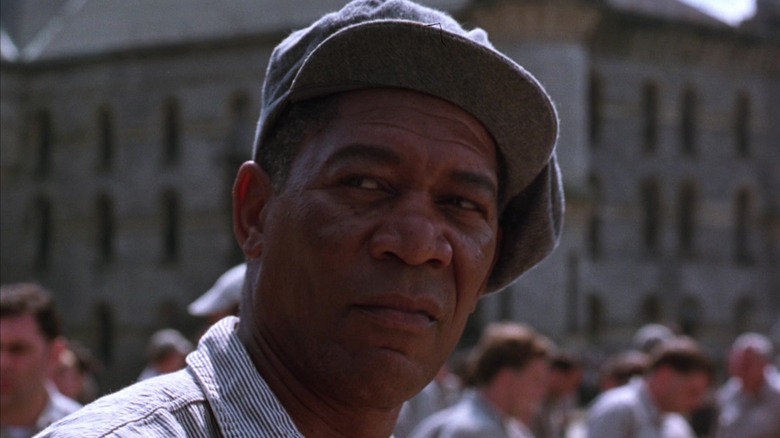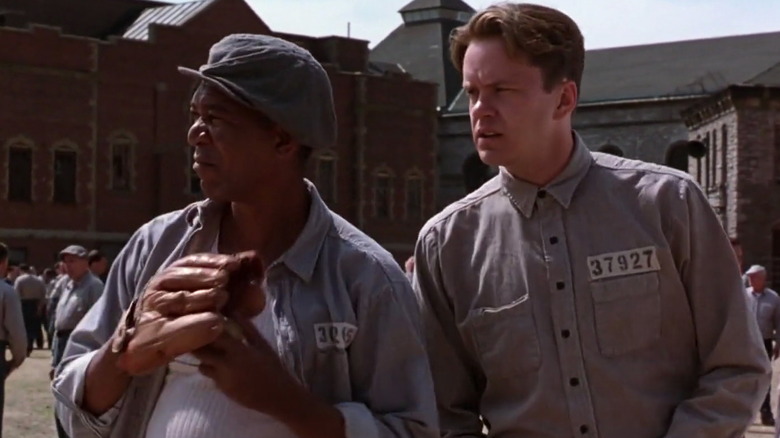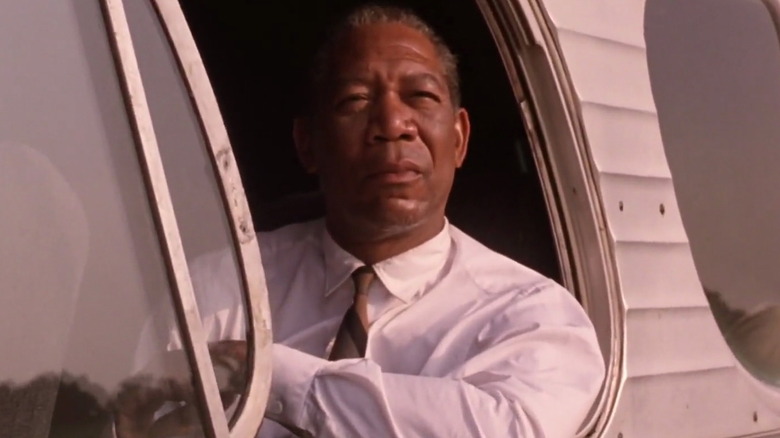The Shawshank Redemption Scene That Put Morgan Freeman In A Sling
"The Shawshank Redemption" is about the friendship between two prison inmates, Red (Morgan Freeman) and Andy Dufresne (Tim Robbins). The film is interesting, touching, and heartbreaking all at the same time. It is generally accepted to be one of the best movies ever made, holding the first spot on IMDb's Top 250 list since 2008, and earning seven Academy Award nominations back in 1995. If you need another reason to respect "Shawshank," it was the first movie to use Freeman's iconic voice as its narrator.
Back in 1993, Mark Dawidziak was working as a film critic for a small local newspaper in Ohio. He was sent to the Ohio State Reformatory to interview Freeman about his role in "Shawshank." The film's poor performance at the box office coupled with the small reach of the paper meant the interview did not get much attention at the time. In 2019, Dawidziak included the conversation with the actor in his book, "The Shawshank Redemption Revealed: How One Story Keeps Hope Alive." During the interview, Freeman talked about finishing a long day of filming saying the shots weren't physically demanding. His body must have disagreed with him because he showed up to set the next day with his arm in a sling.
The first meeting
The day of the interview, Freeman had just finished filming Red and Andy's first meeting. If you've seen the movie, you're probably agreeing with the actor. At first glance, it doesn't seem like there is anything potentially harmful in the scene. In fact, when compared to prisoners being beaten up, a knife being held to someone's throat, and other violence in the movie, it might seem ridiculous that this scene is the one that hurt someone. In reality, like any workplace, film sets are always full of potential risks to the cast and crew. As Freeman found out, something as simple as talking while throwing a baseball back and forth can lead to injury.
The first meeting with Andy shows Red throwing a baseball back and forth as the two talk about smuggling a rock hammer into the prison. In the interview with Dawidziak, Freeman talked about filming this scene, saying: "It's just a conversation that takes place when a few of the prisoners are throwing a baseball around in the prison yard. Nothing to it, right?" He revealed that the director wanted "a lot of takes, covering things from all different angles," which made filming run longer than expected. One extra that worked that day told Dawidziak that Freeman "[threw] the baseball for nine hours."
My arm feels like cement just thinking about it, but the actor dismissed any toll it had taken on his body at the time, saying: "So, you're throwing and catching a baseball, hour after hour. Easy." Either he was not aware of his injury yet, or he was trying to be tough. Either way, he showed up to work the next day with his exhausted arm in a sling. While this would be the only physical injury Freeman had during the filming, he has admitted the experience was emotionally trying.
"Shawshank" had one big challenge in its way that made production hard. It was the passion project of a young, inexperienced director who had spent years of his life obsessing over a Stephen King story, dreaming of the day he could turn it into a movie.
The perfectionist director
King has a complicated history with directors and their adaptations of his work. It's no secret he hated Stanley Kubrick's adaptation of "The Shining," but this has not stopped him from giving other filmmakers a chance. The author has a long-standing practice of offering his short stories to inexperienced directors for one dollar. This sweet deal is how writer-director Frank Darabont would first enter the world of Stephen King adaptations.
In 1983, Darabont adapted King's story, "The Woman in the Room," into a short film that was praised by the author. Not too shabby for a newbie, but the aspiring director had his sights on a much larger project. Darabont admitted to Vanity Fair his true obsession was King's other story, "Rita Hayworth and Shawshank Redemption," but he felt like he wasn't ready for it at the time. Four years later, he was more experienced and had gotten some attention for his screenplay for "A Nightmare on Elm Street 3: Dream Warriors." He went back to King with this experience and got his permission to adapt the story that would become "The Shawshank Redemption." I guess you could say Freddy helped make his dream come true.
Five years later, Darabont wrote "Shawshank" and his script was a hit with Castle Rock Entertainment. While he had added more screenwriting credits to his resume over the years, the studio wanted established director Rob Reiner to helm the film, offering to fund any other movie Darabont wanted to make in exchange. Darabont refused. No guts, no glory, I guess. To say he was under enormous pressure would be an understatement. You'd think having your script described by Freeman as "The best [he has] ever read" would be enough, but not for Darabont. He wanted to prove he could bring that kind of perfection to the screen, which would lead to friction and injury on the set.
In that same Vanity Fair article, Freeman talks about the long days on "Shawshank" and Darabont's perfectionism. Freeman remembers having a few tense encounters with the filmmaker when he was asked to redo scenes over and over. "Acting itself isn't difficult," Freeman said, "but having to do something again and again for no discernible reason tends to be a bit debilitating to the energy," and as he found out, the body, as well.
Freeman's arm healed way before the film received the attention it deserved, but audiences eventually caught on. The role of Red earned him an Academy Award nomination for best actor and introduced the world to the voice that would become a pop culture phenomenon, two things a lot of other actors would probably willingly give an arm for.


